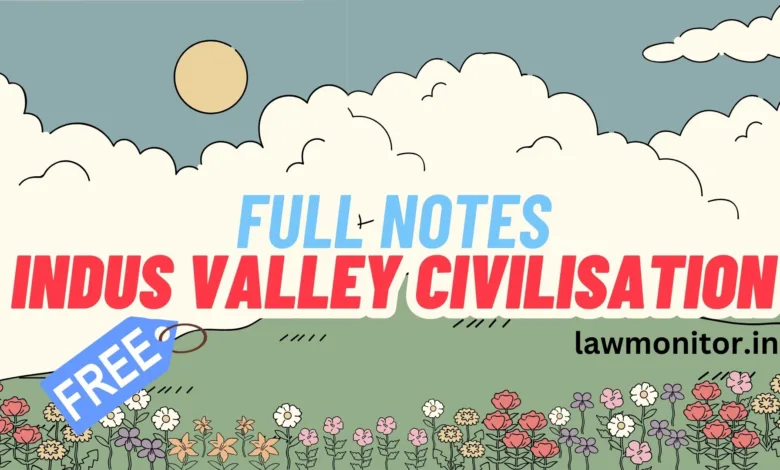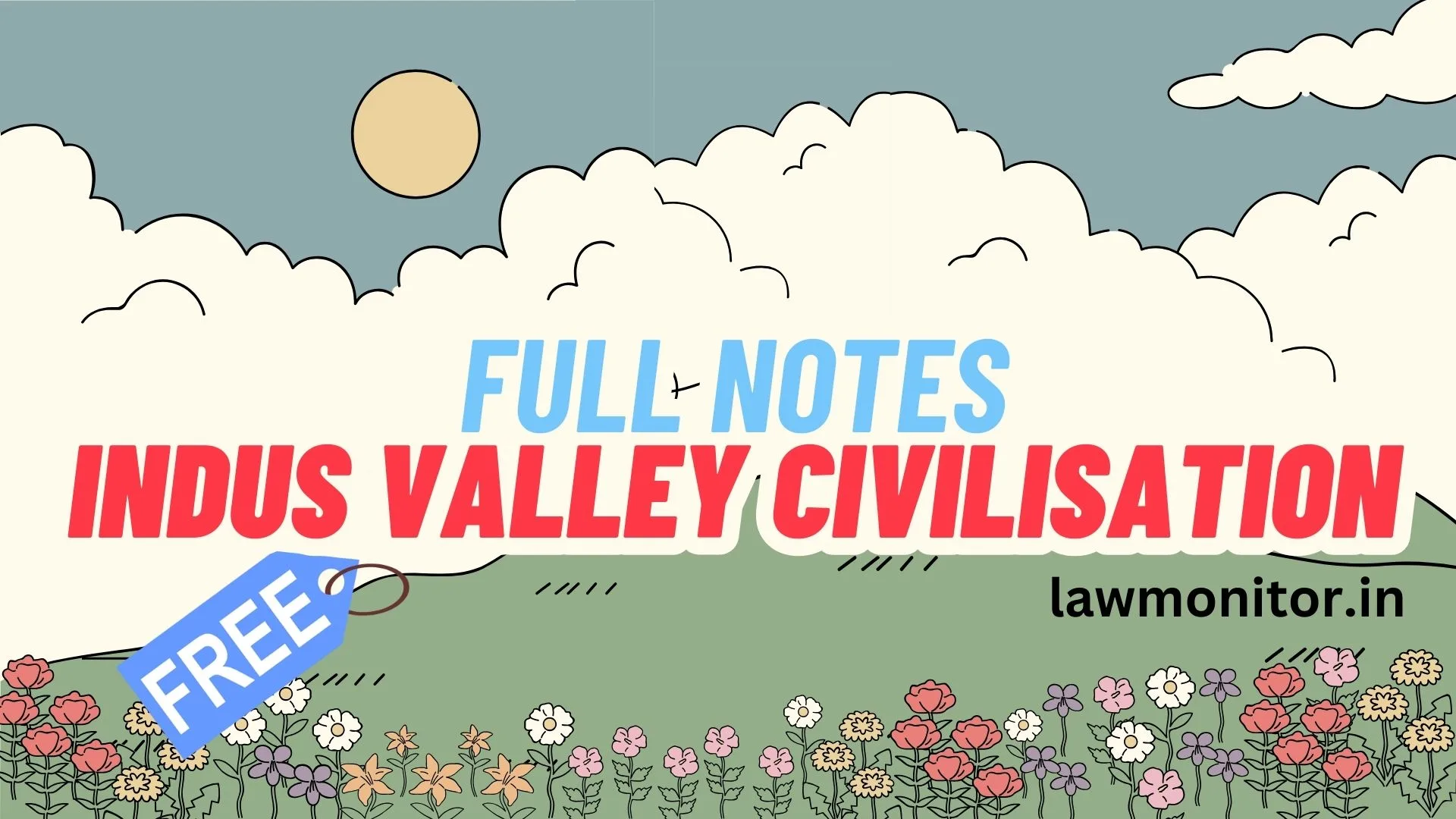History
Indus Valley Civilisation Notes Free: Introduction, Town Planning, Religion, Decline

Introduction
- The history of India begins with the birth of the Indus Valley Civilization (IVC), also known as Harappan Civilization.
- It flourished around 2,500 BC, in the western part of South Asia, in contemporary Pakistan and Western India.
- The Indus Valley was home to the largest of the four ancient urban civilizations of Egypt, Mesopotamia, India and China.
- In 1920s, the Archaeological Department of India carried out excavations in the Indus valley wherein the ruins of the two old cities, viz. Mohenjodaro and Harappa were unearthed.
- In 1924, John Marshall, Director-General of the ASI, announced the discovery of a new civilisation in the Indus valley to the world.
| Site | Excavated by | Location | Important Findings |
| Harappa | Daya Ram Sahini in 1921 | Situated on the bank of river Ravi in Montgomery district of Punjab (Pakistan). | Sandstone, statues of Human, anatomy, Granaries, Bullock carts |
| Mohenjodaro (Mound of Dead) | R.D Banerjee in 1922 | Situated on the Bank of river Indus in Larkana district of Punjab (Pakistan). | Great bath, Granary, Bronze dancing girl, Seal of Pasupathi Mahadeva, Steatite statue of beard man, A piece of woven cotton |
| Sutkagendor | Stein in 1929 | In southwestern Balochistan province, Pakistan on Dast river | A trade point between Harappa and Babylon |
| Chanhudaro | N.G Majumdar in 1931 | Sindh on the Indus river | Bead makers shop, Footprint of a dog chasing a cat |
| Amri | N.G Majumdar in 1935 | On the bank of Indus river | Antelope evidence |
| Kalibangan | Ghose in 1953 | Rajasthan on the bank of Ghaggar river | Fire altar, Camel bones, Wooden plough |
| Lothal | R.Rao in 1953 | Gujarat on Bhogva river near Gulf of Cambay | First manmade port, Dockyard, Rice husk, Fire altars, Chess playing |
| Surkotada | J.P Joshi in 1964 | Gujarat | Bones of horses, Beads |
| Banawali | R.S Bisht in 1974 | Hisar district of Haryana | Beads, Barley, Evidence of both pre-Harappan and Harappan culture |
| Dholavira | R.S Bisht in 1985 | Gujarat in Rann of Kachchh | Water harnessing system Water reservoir |
Phases of IVC
- Three phases of IVC are:
- the Early Harappan Phase from 3300 to 2600 BCE,
- the Mature Harappan Phase from 2600 to 1900 BCE, and
- the Late Harappan Phase from 1900 to 1300 BCE.
- The Early Harappan Phase is related to the Hakra Phase, identified in the Ghaggar-Hakra River Valley.
- The earliest examples of the Indus script date back to 3000 BC.
- This phase stands characterized by centralized authority and an increasingly urban quality of life.
- Trade networks had been established and there are also evidences of the cultivation of crops. Peas, sesame seeds, dates, cotton, etc, were grown during that time.
- Kot Diji represents the phase leading up to Mature Harappan Phase.
- By 2600 BC, the Indus Valley Civilization had entered into a mature stage.
- The early Harappan communities were turning into large urban centers, like Harappa and Mohenjodaro in Pakistan and Lothal in India.
- The signs of a gradual decline of the Indus River Valley Civilization are believed to have started around 1800 BC and by 1700 BC, most of the cities were abandoned.
- However, one can see the various elements of the Ancient Indus Valley Civilization in later cultures.
- Archaeological data indicates the persistence of the Late Harappan culture till 1000-900 BC.

Town Planning and Structures of Indus Valley Civilisation
- The Harappan culture was distinguished by its system of town planning.
- Harappa and Mohenjodaro each had its own citadel or acropolis, which was possibly occupied by members of the ruling class.
- Below the citadel in each city lay a lower town containing brick houses, which were inhabited by the common people.
- The remarkable thing about the arrangement of the houses in the cities is that they followed the grid system.
- Granaries constituted an important part of the Harappan cities.
- The use of burnt bricks in the Harappan cities is remarkable, because in the contemporary buildings of Egypt mainly dried bricks were used.
- The drainage system of Mohenjodaro was very impressive.
- In almost all cities every big or small house had its own courtyard and bathroom.
- In Kalibangan many houses had their wells.
- At sites such as Dholavira and Lothal (Gujarat), the entire settlement was fortified, and sections within the town were also separated by walls.
Agriculture
- The Harappan villages, mostly situated near the flood plains, produced sufficient foodgrains.
- Wheat, barley, rai, peas, sesame, lentil, chickpea and mustard were produced. Millets are also found from sites in Gujarat. While rice uses were relatively rare.
- The Indus people were the earliest people to produce cotton.
- While the prevalence of agriculture is indicated by finds of grain, it is more difficult to reconstruct actual agricultural practices.
- Representations on seals and terracotta sculpture indicate that the bull was known, and archaeologists extrapolate shows oxen were also used for ploughing.
- Most Harappan sites are located in semi-arid lands, where irrigation was probably required for agriculture.
- Traces of canals have been found at the Harappan site of Shortughai in Afghanistan, but not in Punjab or Sindh.
- Although the Harappans practised agriculture, animals were also reared on a large scale.
- Evidence of the horse comes from a superficial level of Mohenjodaro and from a doubtful terracotta figurine from Lothal. In any case the Harappan culture was not horse centred.
Economy of Indus Valley
- The importance of trade in the life of the Indus people is witnessed by the presence of numerous seals, uniform script and regulated weights and measures in a wide area.
- The Harappans carried on considerable trade in stone, metal, shell, etc.
- Metal money was not used and trade was carried by barter system.
- They practised navigation on the coast of the Arabian Sea.
- They had set up a trading colony in northern Afghanistan which evidently facilitated trade with Central Asia.
- They also carried commerce with those in the land of the Tigris and the Euphrates.
- The Harappans carried on long distance trade in lapis lazuli; which may have contributed to the social prestige of the ruling class.
Religion
- In Harappa numerous terracotta figurines of women have been found. In one figurine a plant is shown growing out of the embryo of a woman.
- The Harappans, therefore, looked upon the earth as a fertility goddess and worshipped her in the same manner as the Egyptians worshipped the Nile goddess Isis.
- The male deity is represented on a seal with three horned heads, represented in the sitting posture of a yogi.
- This god is surrounded by an elephant, a tiger, a rhinoceros, and has a buffalo below his throne. At his feet appear two deer.The depicted god is identified as Pushupati Mahadeva.
- Numerous symbols of the phallus and female sex organs made of stone have been found.
- The people of the Indus region also worshipped trees and Animals.
- The most important of them is the one horned unicorn which may be identified with the rhinoceros and the next important was the humped bull.
- Amulets have also been found in large numbers.
Decline of the Indus Valley Civilization
- The IVC declined around 1800 BCE but the actual reasons behind its demise are stilldebated.
- One theory claims that Indo-European tribe i.e. Aryans invaded and conquered the IVC ( Indus Valley Civilisation).
- In later cultures various elements of the IVC are found which suggest that civilization did not disappear suddenly due to an invasion.
- On the other hand, many scholars believe natural factors are behind the decline of the IVC.
- The natural factors could be geological and climatic.
- It is believed that the Indus Valley region experienced several tectonic disturbances which causes earthquakes. Which also changed courses of rivers or dried them up.
- Another natural reason might be changes in patterns of rainfall.
- There could be also dramatic shifts in the river courses, which might have brought floods to the food producing areas.
- Due to combination of these natural causes there was a slow but inevitable collapse of IVC.

